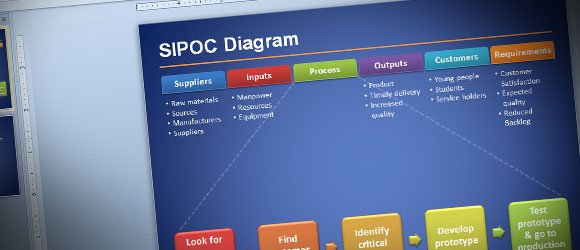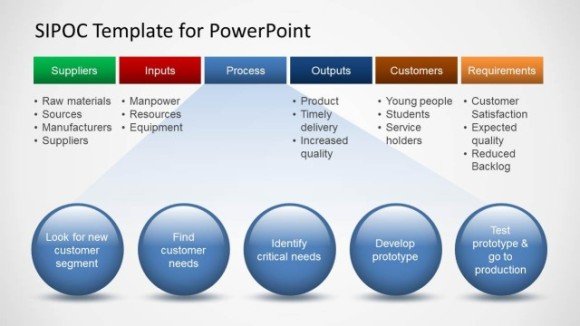SIPOC Diagram for Six Sigma Presentations in Microsoft PowerPoint
In the complex landscape of business process improvement, the SIPOC model emerges as a beacon, providing structure, clarity, and direction. An acronym for Suppliers, Inputs, Process, Outputs, and Customers, SIPOC has proven its value across various industries, from manufacturing to services. This article explores the power of SIPOC as a tool for enhancing process efficiency. We’ll delve into its definition, use cases, and alternatives, and guide you through its creation and implementation. Moreover, we’ll shed light on how the SIPOC model can play a pivotal role in your business strategy and digital transformation journey. If you need to prepare Six Sigma presentations using PowerPoint, you can download a free SIPOC Template for PowerPoint presentations (available for free download here). It is a free design and editable template that you can download to make presentations on Six Sigma using PowerPoint.

What is SIPOC?
SIPOC is a highly beneficial tool utilized in process improvement, particularly in methodologies such as Six Sigma, Lean manufacturing, and Total Quality Management (TQM). SIPOC is an acronym that stands for Suppliers, Inputs, Process, Outputs, and Customers. This model succinctly summarizes the essential elements of a process in a table form. It offers a macro view of a process, which can be critical in identifying potential improvements and eliminating inefficiencies.
Originally developed for manufacturing industries, SIPOC has evolved and found utility across various sectors, including service industries and IT. Its applicability and effectiveness make it a sought-after tool in contemporary business process management.
Understanding SIPOC Model
The SIPOC model, organized as a table, involves five components:
- Suppliers: Entities providing necessary input for the process. They can be internal or external to the organization.
- Inputs: The raw materials or information required to conduct the process.
- Process: The steps or activities conducted to transform inputs into outputs. This is typically displayed at a high level, typically between five to seven steps.
- Outputs: The results, products, or services produced by the process.
- Customers: The recipients of the outputs. Like suppliers, these can be within or outside the organization.
To enhance customer-centric thinking, an alternative version, COPIS (Customers, Outputs, Process, Inputs, Suppliers), is used. The information is filled in starting with the customer and working upstream to the supplier.
SIPOC PowerPoint Templates
SIPOC is a concept used in process improvement (aka COPIS) that can be used as a tool that summarizes the inputs and outputs of one or more processes in table form. The acronym SIPOC stands for suppliers, inputs, process, outputs, and customers which form the columns of the table. It was in use at least as early as the Total Quality Management programs of the late 1980 and continues to be used today in Six Sigma and Lean manufacturing.
To emphasize putting the needs of the customer foremost, the tool is sometimes called COPIS and the process information is filled in starting with the customer and working upstream to the supplier. he SIPOC is often presented at the outset of process improvement efforts such as Kaizen events or during the “define” phase of the DMAIC process. You can also download other TQM PowerPoint templates including the continuous improvement PowerPoint template.

This free SIPOC diagram comes with a single slide inside the PPT template and you can edit the text inside the shape or customize the SIPOC diagram to match your organizational needs.
SIPOC Six Sigma Template (10060 downloads )If you need a professional SIPOC PowerPoint presentation template then you can consider to subscribe to SlideModel and download SIPOC Template.

Use Cases of SIPOC Model
The SIPOC model is often introduced at the start of process improvement initiatives, such as Kaizen events, or during the “define” phase of the DMAIC (Define, Measure, Analyze, Improve, Control) process. Some of its prominent use cases are:
- Process Documentation: SIPOC helps in developing a comprehensive understanding of a process, particularly useful for onboarding new team members or transitioning processes.
- Process Improvement: SIPOC helps identify potential process inefficiencies and gaps, guiding effective improvement strategies.
- Stakeholder Communication: SIPOC’s visual format facilitates clear communication with stakeholders, including suppliers and customers, regarding process functioning and improvements.
- Strategic Planning: SIPOC can aid in decision-making by providing a holistic view of existing processes and their potential impact on organizational strategy.
Alternatives to SIPOC Model
While SIPOC is a versatile tool, there are alternatives that organizations can consider based on their specific needs:
- Process Mapping or Flowcharting: Visual representations of the process steps, useful for complex processes with multiple decision points.
- Value Stream Mapping (VSM): A Lean tool that illustrates material and information flows, highlighting value-adding and non-value-adding activities.
- Business Process Model and Notation (BPMN): A standard for graphical representation of business processes in a workflow.
Creating a SIPOC Diagram
While the article above suggests PowerPoint for creating SIPOC diagrams, there are several other tools available such as Microsoft Excel, Visio, Google Slides, PowerPoint, and specialized process improvement software. The selection of tool depends on the complexity of the process and the organization’s preferences. With the free SIPOC template provided in this article, you will be able to create and customize a SIPOC diagram using PowerPoint or Google Slides.
Further Enhancements for Your SIPOC Model
Your SIPOC diagram can be enriched by integrating additional information, such as:
- Process Owner: Identify who is accountable for the process.
- Process Metrics: Specify metrics used to measure the process performance.
- Risks and Controls: Highlight potential risks in the process and control measures in place.
SIPOC in the Age of Digital Transformation
In the age of digital transformation, SIPOC remains as relevant as ever. Digital processes also have suppliers, inputs, outputs, and customers, and the ability to understand and improve these digital processes can provide a competitive advantage. Tools for creating digital SIPOC diagrams are readily available, and the principles for applying SIPOC to digital processes remain the same.
Conclusions
The SIPOC model is a powerful tool for understanding and improving business processes. It provides a high-level view of the process that is both comprehensive and concise. By identifying suppliers, inputs, the process itself, outputs, and customers, it encourages businesses to focus on critical aspects of their operations. This enables a deeper understanding of how processes interact, how they contribute to the company’s output, and who the key stakeholders are.

Notes